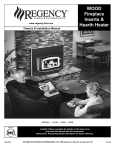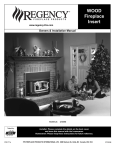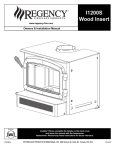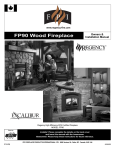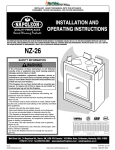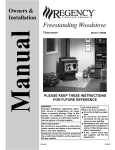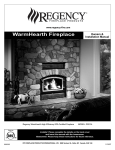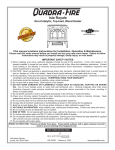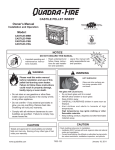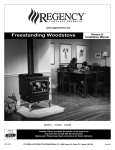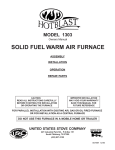Download Hampton Direct HI300 User's Manual
Transcript
www.hampton-fire.com Wood Cast Insert MODEL: Tested by: 918-240e Owners & Installation Manual HI300 Installer: Please complete the details on the back cover and leave this manual with the homeowner. Homeowner: Please keep these instructions for future reference. FPI FIREPLACE PRODUCTS INTERNATIONAL LTD. 6988 Venture St., Delta, BC Canada, V4G 1H4 07/18/06 Thank-you for purchasing a HAMPTON FIREPLACE PRODUCT. The pride of workmanship that goes into each of our products will give you years of trouble-free enjoyment. Should you have any questions about your product that are not covered in this manual, please contact the HAMPTON DEALER in your area. Keep those HAMPTON FIRES burning. SAFETY NOTE: If this Insert is not properly installed, a house fire may result. For your safety, follow the installation instructions, contact local building, fire officials, or authority having jurisdiction about restrictions and installation inspection requirements in your area. The authority having jurisdiction should be consulted before installation to determine the need to obtain a permit. 2 Hampton HI300 Wood Cast Insert TABLE OF CONTENTS SAFETY LABEL OPERATING INSTRUCTIONS Safety Label For HI300 .................................................4 Safety Guidelines ........................................................14 First Fire ......................................................................14 Wood Storage..............................................................15 Creosote ......................................................................15 Ash Disposal ...............................................................15 Fan Operation ............................................................15 UNIT DIMENSIONS Unit Dimensions ............................................................5 INSTALLATION Before Installing Your Insert ..........................................6 Chimney Specifications .................................................6 Wood Insert Specifications ............................................6 Masonry And Factory Built Fireplace Clearances ........7 How To Determine If Alternate Floor Protection Materials Are Acceptable ....................7 Flue Connector Bracket .................................................8 Installing Your Insert ......................................................8 Optional Flue Connector Kit ..........................................8 Installation Into a Masonry Fireplace .............................9 Installation Into a Factory Built Fireplace ......................9 Cast Faceplate Installation ..........................................10 Fan Installation ............................................................12 Draft Control ................................................................13 Firebrick Assembly ......................................................13 Flue Baffle & Secondary Air Tube Installation .............13 MAINTENANCE Door Gasket ................................................................16 Glass Cleaning ............................................................16 Door Removal .............................................................16 Glass Replacement .....................................................16 Handle Replacement ...................................................16 Latch Adjustment .........................................................17 PARTS LIST HI300 Main Assembly ..................................................18 HI300 Cast Faceplate ..................................................19 HI300 Brick Panels ......................................................20 WARRANTY Warranty ......................................................................23 Hampton HI300 Wood Cast Insert 3 264 DO NOT REMOVE THIS LABEL A) B) C) D) 11 in / 280 mm 20 in / 508 mm 12 in / 305 mm 8 in / 200 mm A F B E C G D INSTALL ONLY ON A NON-COMBUSTIBLE HEARTH RAISED (F) 0.5IN / 13MM ABOVE AN ADJACENT COMBUSTIBLE FLOOR. COMBUSTIBLE FLOOR MUST BE PROTECTED BY NONCOMBUSTIBLE MATERIAL EXTENDING (E) 18 IN / 457 MM TO FRONT AND (G) 8 IN / 205 MM TO SIDES FROM FUEL DOOR. 0.5" FLOOR PROTECTION NEEDS TO BE WITH k=0.84. COMPONENTS REQUIRED FOR INSTALLATION: 6IN / 150MM STAINLESS STEEL LINER. DANGER: RISK OF ELECTRIC SHOCK. DISCONNECT POWER BEFORE SERVICING UNIT. DO NOT ROUTE POWER CORD UNDER OR IN FRONT OF APPLIANCE. DO NOT CONNECT THIS UNIT TO A CHIMNEY FLUE SERVICING ANOTHER APPLIANCE. DO NOT REMOVE BRICKS OR MORTAR IN MASONRY FIREPLACE. FOR USE WITH SOLID WOOD FUEL ONLY. DO NOT USE GRATE OR ELEVATE FIRE. BUILD WOOD FIRE DIRECTLY ON HEARTH. OPERATE WITH FEED DOOR CLOSED, OPEN FEED DOOR TO FEED FIRE ONLY. REPLACE GLASS ONLY WITH CERAMIC GLASS (5MM). INSPECT AND CLEAN CHIMNEY FREQUENTLY. UNDER CERTAIN CONDITIONS OF USE CREOSOTE BUILDUP MAY OCCUR RAPIDLY. DO NOT OVERFIRE, IF INSERT GLOWS YOU ARE OVER-FIRING. ADJACENT SIDEWALL MANTLE TOP FACING SIDE FACING MINIMUM CLEARANCES TO COMBUSTIBLE MATERIALS (MEASURED FROM INSERT BODY) ADJ AC ENT S IDEWAL L MADE IN CANADA 918-241 Manufactured By: FIREPLACE PRODUCTS INTERNATIONAL LTD. 6988 VENTURE ST., DELTA, BC V4G 1H4 HOT WHILE IN OPERATION DO NOT TOUCH. KEEP CHILDREN, CLOTHING AND FURNITURE AWAY. CONTACT MAY CAUSE SKIN BURNS. READ ABOVE INSTRUCTIONS. CAUTION Jan June Dec 2007 2006 2005 Nov Apr May July Aug Sept Oct Feb Mar DATE OF MANUFACTURE 4 NOTE: Hampton units are constantly being improved. Check the label on the unit and if there is a difference, the label on the unit is the correct one. SIGNATURE This is a copy of the label that accompanies your Hampton Insert. We have printed a copy of the contents here for your review. INSTALL AND USE ONLY IN ACCORDANCE WITH THE MANUFACTURER'S INSTALLATION AND OPERATING INSTRUCTIONS. INSTALL AND USE ONLY IN MASONRY FIREPLACE OR FACTORY BUILT FIREPLACE. CONTACT LOCAL BUILDING OR FIRE OFFICIALS ABOUT RESTRICTIONS AND INSTALLATION INSPECTION IN YOUR AREA. LISTED FACTORY BUILT FIREPLACE INSERT CERTIFIED FOR USE IN CANADA AND U.S.A. MODEL: HI300 TESTED TO: ULC S628 / UL 1482 REPORT NO.: 219-S-03-02 SAFETY LABEL SAFETY LABEL FOR HI300 Hampton HI300 Wood Cast Insert UNITED STATES ENVIRONMENTAL PROTECTION AGENCY CERTIFIED TO COMPLY WITH July 1990, PARTICULATE EMISSION STANDARDS. MANUFACTURED BY FPI LTD. UNIT DIMENSIONS 23-3/4” NOTE: Before assembling your Insert, use these dimensions to ensure appropriate clearances will be met (refer to Masonry and Factory Built Fireplace Clearances section). 9” 11-3/8” 11-1/8” 17-1/4” 23-1/4” 30-7/8" 8-1/2" 42-1/2” 40” 21-1/2” 30” 41” 7-3/4” Hampton HI300 Wood Cast Insert 5 INSTALLATION Hampton Inserts are constructed with the highest quality materials and assembled under strict quality control procedures that insure years of trouble free and reliable performance. It is important that you read this manual thoroughly and fully understand the safe installation and operating procedures. The more you understand the way your Hampton Insert operates, the more enjoyment you will experience from knowing that your unit is operating at peak performance. BEFORE INSTALLING YOUR INSERT 1) Please read this entire manual before you install and use your new wood insert. Failure to follow instructions may result in property damage, bodily injury or even death. Install and use only in accordance with manufacturer’s installation and operating instructions. 2) Check your local building codes - Building Inspection Department. You may require a permit before installing your insert. Be aware that local codes and regulations may override some items in the manual. WARNING: Careless installation is the major cause of safety hazard. Check all local building and safety codes before installation of unit. 3) Notify your home insurance company that you plan to install a fireplace insert. 4) Your fireplace insert is heavy and requires two or more people to move it safely. The insert can be badly damaged by mishandling. 5) If your existing fireplace damper control will become inaccessible once you have installed your Hampton Insert, you should either remove or secure it in the open position. 6) Inspect your fireplace and chimney prior to installing your insert to determine that it is free from cracks, loose mortar or other signs of damage. If repairs are required, they should be completed before installing your insert. Do not remove bricks or mortar from your masonry fireplace. 7) Do not connect the insert to a chimney system servicing another appliance or an air distribution duct. CHIMNEY SPECIFICATIONS Before installing, check and clean your chimney system thoroughly. If in doubt about its condition, seek professional advice. Your Hampton Insert is designed for installation into a masonry fireplace that is constructed in accordance with the requirements of "The Standard for Chimneys, Fireplaces, Vents, and Solid Fuel Burning Appliance", N.F.P.A. 211, the National Building Code of Canada, or the applicable local code requirements. The appliance, when installed, must be electrically grounded in accordance with local codes or, in the absence of local codes, with the National Electrical Code, ANSI/NFPA 70, or the Canadian Electrical code, CSA C22.1. Hampton Inserts are designed with a 6" (152mm) flue. Requirements for Installing Solid-fuel Inserts in Factory-built Fireplaces. 1) The insert must be tested and meet the requirements of UL 1482 (U.S.) and or ULC S628 (Canada) when tested in a masonry fireplace built per ULC S628. 2) The factory-built fireplace must be listed per UL 127 or ULC S610. 3) Clearances obtained from the masonry fireplace tests are also relevant for installation in factory-built fireplaces. 4) Installation must include a full height listed chimney liner type HT requirements (2100 degree F.) per UL 1777 (U.S.) or ULC S635 (Canada). The liner must be securely attached to the insert flue collar and the chimney top. 5) Means must be provided to prevent room air passage to the chimney cavity of the fireplace. This may be accomplished by sealing the damper area around the chimney liner, or sealing the fireplace front. 7) Alteration of the fireplace in any manner is not permitted with the following exceptions; a. external trim pieces which do not affect the operation of the fireplace may be removed providing they can be stored on or within the fireplace for re-assembly if the insert is removed. b. the chimney damper may be removed to install the chimney liner. 8) Circulating air chambers (i.e. in a steel fireplace liner or metal heat circulator) shall not be blocked. 9) Means must be provided for removal of the insert to clean the chimney flue. 10) Inserts that project in front of the fireplace must be supplied with appropriate supporting means. 11) Installer must mechanically attach the supplied label to the inside of the firebox of the fireplace into which the insert is installed. "WARNING: This fireplace has been converted for use with a wood insert only and cannot be used for burning wood or solid fuels unless all original parts have been replaced, and the fireplace re-approved by the authority having jurisdiction." In order for a solid-fuel insert to be certified for use in factory-built fireplaces, the above information must be clearly stated in the installation manual and appropriate markings. Final approval is contingent on the authority having jurisdiction. WOOD INSERT SPECIFICATIONS Your fireplace opening requires the following minimum sizes: Height Width Depth 21.5" 25" 17.5" 6) The air flow within and around the fireplace shall not be altered by the installation of the insert (i.e. no louvers or cooling air or outlet ports are blocked), unless specifically tested as such for each factory - built fireplace manufacturer and model line. (Note: using a louvered face plate (surround) complies with this requirement). Emissions from burning wood or gas could contain chemicals known to the State of California to cause cancer, birth defects or other reproductive harm. 6 Hampton HI300 Wood Cast Insert INSTALLATION MASONRY AND FACTORY BUILT FIREPLACE CLEARANCES The minimum required clearances to combustible materials when installed into a masonry or factory built fireplace are listed below. Unit Wood Cast Insert (HI300) Adjacent Side Wall (to Side of unit) A 11"/280mm Mantle** (to Top) B Top Facing (to Top) C Side Facing (to Side of unit) D Minimum Hearth Extension* E 20"/508mm 12"/305mm 8"/200mm 18"/455mm Minimum Hearth Thickness* F Minimum Hearth Side Extension G 0.5"/13mm 8"/200mm Side and Top facing is a maximum of 1.5" thick. Floor protection must be non-combustible, insulative material with an R value of 1.1 or greater. * Hearth thickness of 0.5" with k value = 0.84", R value = 0.6 or greater. Thermal floor protection not required if unit is raised 3.5" min. measured from bottom of stove. At this point the standard ember floor protection will be required. It will need to be a non-combustible material that covers 16" (406 mm) to the front of the unit (in Canada 18" (450 mm) and 8" (200 mm) to the sides. All floor protection must be non-combustible (i.e., metals, brick, stone, mineral fiber boards, etc.) Any organic materials (i.e. plastics, wood paper products, etc.) are combustible and must not be used. The floor protection specified includes some form of thermal designation such as R-value (thermal resistance) or k-factor (thermal conductivity). ** A non-combustible mantel may be installed at a lower height if the framing is made of metal studs covered with a non-combustible board. ** Max. mantle depth is 10" (254mm) Clearance Diagram for Installations Minimum Hearth Extension for the front (E) and sides (G) are measured from the fuel door opening. HOW TO DETERMINE IF ALTERNATE FLOOR PROTECTION MATERIALS ARE ACCEPTABLE The specified floor protector should be 3/8" (18mm) thick material with a K - factor of 0.84. The proposed alternative is 4" (100mm) brick with a C-factor of 1.25 over 1/8" (3mm) mineral board with a K-factor of 0.29. Step (a): Use formula above to convert specification to R-value. R = 1/k x T = 1/0.84 x .75 = 0.893. Step (b): Calculate R of proposed system. 4" brick of C = 1.25, therefore Rbrick = 1/C = 1/1.25 = 0.80 1/8" mineral board of k = 0.29, therefore Rmin.bd. = 1/0.29 x 0.125 = 0.431 Total R = Rbrick + Rmineral board = 0.8 + 0.431 = 1.231. Step (c): Compare proposed system R of 1.231 to specified R of 0.893. Since proposed system R is greater than required, the system is acceptable. DEFINITIONS Thermal Conductance: C Btu (hr)(ft2 )(oF) = W (m2))(K) Thermal Conductivity: k = (Btu)(inch) (hr)(ft3)(oF) = W (m)(K) = Btu (hr)(ft)(oF) Thermal Resistance: R Hampton HI300 Wood Cast Insert = = (ft2)(hr)(oF) = Btu (m2)(K) W 7 INSTALLATION STOP! PLEASE READ CAREFULLY. CAST COMPONENTS ARE VERY FRAGILE. USE EXTREME CARE WHEN HANDLING. WARNING DO NOT LIFT OR PUSH THE UNIT FROM THE ASHLIP, LEFT SIDE CAST or RIGHT SIDE CAST. THE CASTING WILL CHIP OR BREAK. INSTALLING YOUR INSERT Your insert is very heavy and will require two or three people to move it into position. 1) Remove the Door to make the insert easier to handle. To remove the Door, open fully and lift it up off its hinges. Refer to the Door Removal section for an important note on installation. Left Side Cast Right Side Cast Ashlip Hinges DO NOT LIFT UNIT FROM THESE PARTS. OPTIONAL FLUE CONNECTOR KIT The Straight Flue Adaptor (Part #846-504) shown here, may be used to produce a secure connection between your flue connector and the insert collar. Detailed installation instructions are included with the kit. Door FLUE CONNECTOR BRACKET 2) NOTE: For Masonry installation make sure that the firebox is level with the hearth using non-combustible materials and no more than 1/2 to 1 inch of the leveling bolt. Package contains: 3 brackets and 6 screws. These brackets are to be used to hold the flue liner (not supplied) to the Insert and keep the connection. The brackets are screwed into the top of the Insert in the pre-punched holes and then screwed into the flue liner. 3) Lift the unit up onto the Hearth and slide into the fireplace opening. Be sure to leave the unit out at least 3 to 4 inches in order to make the necessary flue connections and to install the faceplate. Be sure to protect your hearth extension during the installation, ie. with a heavy blanket. 8 Hampton HI300 Wood Cast Insert INSTALLATION INSTALLATION INTO A MASONRY FIREPLACE INSTALLATION INTO A FACTORY BUILT FIREPLACE The insert must be installed as per the requirements of your local inspection authority. While a full liner is preferred, three methods of flue connection are acceptable in most areas in the US, however in Canada a full flue liner is required. 1) When installed in a factory built fireplace, a full stainless steel rigid or flexible flue liner is mandatory, for both safety and performance purposes. When a flue or liner is in use, the insert is able to breathe better by allowing a greater draft to be created. The greater draft can decrease problems such as, difficult start-ups, smoking out the door, and dirty glass. 1) Positive flue connection, where a large blocking plate and a short connector pipe is used. 2) Direct flue connection, where a smaller blocking plate and a connector pipe to the first flue liner tile is used. 3) Full flue liner, where a stainless steel rigid or flexible liner pipe is routed from the insert outlet collar to the top of the chimney. Hampton highly recommends the use of a full liner as the safest installation and provides the most optimum performance. Your retailer should be able to help you decide which system would be the best for your application. 2) In order to position the flue liner, the existing rain cap must be removed from your chimney system. In most cases the flue damper should also be removed to allow passage of the liner. 3) In most cases opening the existing spark screens fully should give enough room for the insert installation. If it does not, remove and store. 4) If the floor of your fireplace is below the level of the fireplace opening, adjust the insert's levelling bolts to accommodate the difference. When additional shimming is required, use non-combustible masonry or steel shims. 5) Measure approximately the alignment of the flue liner with the position of the smoke outlet hole on the insert to check for possible offset. If an offset is required, use a proper stainless steel unit available with the chimney liner. 6) Once the above items have been checked, slide your insert into position after first positioning the flue liner and offset if required. (Re-install raincap at completion of installation). NOTE: See requirements for installing solid fuel inserts in factory built fireplaces. 2) Direct Flue Connection with Cleanout 1) Positive Flue Connection with Cleanout 3a) Full Flue Liner (No Cleanout Required) Note: A clean-out door is sometimes required, by your inspector, to be installed when either the Positive flue connection or Direct flue connection method is used. The use of one of the connection methods listed on this page not only increases the safety of your insert by directing the hot gases up the flue, but will also help increase the unit's efficiency and decrease creosote deposits in the chimney. When a connected flue or liner is in use, the insert is able to “breathe” better by allowing a greater draft to be created. The greater draft can decrease problems such as, difficult start-ups, smoking out the door, and dirty glass. Hampton HI300 Wood Cast Insert 9 INSTALLATION CAST FACEPLATE INSTALLATION Stop! Please Read Carefully. Cast components are very fragile. Use extreme care when handling. 1) Secure the Side Mounting Brackets (packaged with Faceplate) to the left and right side of the firebox using 4 bolts per mounting bracket as shown in the diagram below. 3) Place Mantel Top onto the top of the firebox. Mantel Top Side Mounting Bracket Backside of Unit Shown. 2) Secure the Left and Right Side Faceplate to the firebox by aligning the Mounting Holes with the Side Mounting Brackets taking care to align vertically while each side rests on the hearth. Secure using 1 bolt per bracket. Side Mounting Bracket Mounting Hole 4) Slowly slide the Mantel Top forward until it stops. Slide Mantel Top forward. Right Side Faceplate Left Side Faceplate Backside of Unit & Faceplate Shown. 10 Hampton HI300 Wood Cast Insert INSTALLATION 5) Mount the Top Faceplate by carefully sliding the Mounting Plates on the Left and Right Side Faceplate thru the Retainers in the Top Faceplate. NOTE: Slowly lower the Top Faceplate into position; being careful not to damage the Mantel Top. Retainer 7) Location of Insulations a) Place 1 piece of Insulation behind the Mantel Top. b) Cut the second piece of Insulation in half, then install behind both the Left and Right Sides as shown. Insulation Top Faceplate Mounting Plates 8) The unit may now be slid into final position. Left Side Faceplate Right Side Faceplate Backside of Unit & Faceplate Shown. 6) Carefully slide the Mantel Top back into position. Slide Mantel Top back. Hampton HI300 Wood Cast Insert 11 INSTALLATION FAN INSTALLATION Your fan should only be installed once the unit is in place in order to prevent any damage to the fan. 1) Attach the Left and Right Side Fan Facia to the Front Fan Facia by aligning the Side Facia screw slots with the hole locations in the Front Fan Facia and secure using 2 screws per side. IMPORTANT Ensure that the Left and Right Side Fan Facia do not hit the sides of the Faceplate when sliding the Fan into position as the casting may chip. If the spacing between the Side Fan Facia and the Faceplate requires adjustment, the Side Fan Facia's can be slightly pushed in or pulled out to fit accordingly. Front Fan Facia Left Side Fan Facia 3) Ensure that the power cord is not in contact with any hot stove surfaces. Right Side Fan Facia Backside of Fan Facia Shown. 2) Once the Fan Facia has been assembled carefully slide the Fan into position by centering the Fan below the Ashlip and align the Fan Support Clips with the Offset Clips under the Ashlip. DO NOT ROUTE POWER CORD UNDER OR IN FRONT OF UNIT. Do not turn the fan ON until your insert has reached operating temperature or at least 30 minutes after starting fire. Note: The Draft Control Rod is to fit through the top opening in the Switch Plate. Draft Control Rod 12 Ashlip Fan Support Clips Switch Plate Hampton HI300 Wood Cast Insert INSTALLATION FIREBRICK ASSEMBLY Firebrick is included to extend the life of your insert and radiate heat more evenly. Check to see that all firebricks are in their correct positions and have not become misaligned during shipping. hand side, as far as possible and then bring it back into the hole on the right hand side. Use a pair of vise grips or pliers and tap it into place with a hammer. A tighter fit will ensure the tube will not move when the unit is burning. Though there are four air tubes in the medium units. 2) Slide the left baffle over the air tubes from the front and then push it to the back. DRAFT CONTROL Before establishing your first fire, it is important that your fully understand the operation of you draft control. The draft rod is on the left side of the Inserts and it controls the intensity of the fire by increasing or decreasing the amount of air allowed into the firebox. To increase your draft - pull open, and to decrease - push closed. As well as a primary and glass wash air system, Pull Open Side View 3) Tilt the left baffle up on top of the side channel and it will leave enough room to position the right baffle in the same manner as Step 1) above. Then reposition the left baffle flat on the air tubes. Push Closed the unit has a full secondary draft system that allows air to the induction ports at the top of the firebox, just below the flue baffle. WARNING: To build a fire in ignorance or to disregard the information contained in this section can cause serious permanent damage to the unit and void your warranty. FLUE BAFFLE & SECONDARY AIR TUBE INSTALLATION The flue baffle system located in the upper area of the firebox is removable to make cleaning your chimney system easier. The baffles must be installed prior to your first fire. Smoke spillage and draft problems may occur if the baffles are improperly positioned. Check the position of the baffles on a regular basis as they can be dislodged if too much fuel is forced into the firebox. Front View 4) Important: push both baffles so they are tight against the side walls. The unit arrives with the 2 baffle plates on the floor of the firebox. 1) If all 4 air tubes are installed continue on to Step 2), if not, follow the instructions below. Install the air tube into the holes in the side channels. The notch goes on the right hand side with the air holes facing toward the door. Slide the tube into the left Hampton HI300 Wood Cast Insert Front View 13 OPERATING INSTRUCTIONS SAFETY GUIDELINES 1) Never use gasoline, gasoline type lantern fuels, kerosene, charcoal lighter fuel, or similar liquids to start or ‘freshen up’ a fire in your heater. Keep all such liquids well away from the heater while it is in use. 2) Keep the door closed during operation and maintain all seals in good condition. 3) Do not burn large quantities of paper in your insert. 4) If you have smoke detectors, prevent smoke spillage as this may set off a false alarm. 5) Do not overfire your insert. If the insert begin to glow, you are overfiring. Stop adding fuel and close the draft control. Overfiring can cause extensive damage to your stove including warpage and premature steel corrosion. Overfiring will void your warranty. 6) Do not permit creosote or soot buildup in the chimney system. Check and clean chimney at regular intervals. 7) Your Hampton Insert can be very hot. You may be seriously burned if you touch the insert while it is operating. Warn children of the burn hazard. 8) The insert consumes air while operating, provide adequate ventilation with an air duct or open a window while the insert is in use. 9) Do not use grates, irons or other methods for supporting fuel. Burn directly on the bricks. 10) Open the draft control fully for 10 to 15 seconds prior to slowly opening the door when refuelling the fire. 11) Do not connect your unit to any air distribution duct. 14) Do not burn salt drift wood as it will corrode your unit and void the warranty. 15) Do not operate the unit if the glass is broken or missing. Do not operate the unit if the gasketing is worn out and not sealing the door or the glass. It is very important to carefully maintain your insert, including burning seasoned wood and maintaining a clean stove and chimney system. Have the chimney cleaned before the burning season and as necessary during the season, as creosote deposits may build up rapidly. Moving parts of your insert require no lubrication. FIRST FIRE When your installation is completed and inspected, you are ready for your first fire. 1) Open draft control fully. 2) Open firebox door and build a small fire using paper and dry kindling on the firebrick hearth, wait a few minutes for a good updraft in the flue to establish the fire. Leaving the door slightly open will help your fire start more rapidly. CAUTION: Never leave unit unattended if door is left open. This procedure is for fire start-up only, as unit may over-heat if door is left open for too long. 3) With the draft still in the fully open position, add two or three seasoned logs to your fire. Form a trench in the ash bed to allow air to reach the rear of the firebox prior to closing the door. 4) After about 15 to 20 minutes, when your wood has begun to burn strongly, adjust your draft control down to keep the fire at a moderate level. 12) Your insert should burn dry, standard firewood only. The use of “mill ends” is discouraged as this fuel can easily overheat your insert. Evidence of excessive overheating will void your warranty. As well, a large portion of sawmill waste is chemically treated lumber, which is illegal to burn in many areas. Chemically treated fire logs also must not be burned in your insert. WARNING: Never build a roaring fire in a cold stove. Always warm your stove up slowly! 13) Do not store any fuel closer than 2 feet from your unit. 6) During the first couple of hours, keep the combustion rate at a moderate level and avoid a large fire until the paint is cured. Only then can you operate the insert at its maximum setting, and only after the metal has been warmed. 14 5) Once a bed of coals has been established, you may adjust the draft control to a low setting to operate the unit in its most efficient mode. 7) For the first few hours, the insert will give off an odor from the paint. This is to be expected as the high temperature paint becomes seasoned. Windows and/or doors should be left open to provide adequate ventilation while this temporary condition exists. Burning the insert at a very high temperature the first few times may damage the paint. Burn fires at a moderate level the first few days. 8) Do not place anything on the insert top during the curing process. This may result in damage to your paint finish. 9) During the first few hours it may be more difficult to start the fire. As you dry out your fire brick and your masonry flue (if applicable), your draft will increase. 10) For those units installed at higher elevations or into sub-standard masonry fireplaces, drafting problems may occur. Consult an experienced dealer or mason on methods of increasing your draft. 11) Some cracking and popping noises may be experienced during the heating up process. These noises will be minimal when your unit reaches temperature. 12) Before opening your door to reload, open draft fully for approximately 10 to 15 seconds until fire has been re-established. This will minimize any smoking. 13) All fuel burning appliances consume oxygen during operation. It is important that you supply a source of fresh air to your unit while burning. A slightly opened window is sufficient for this purpose. CAUTION: If the body of your unit starts to glow you are overfiring. Stop loading fuel immediately and close the draft control until the glow has completely subsided. 14) Green or wet wood is not recommended for your unit. If you must add wet or green fuel, open the draft control fully until all moisture has been dispersed by the intense fire. Once all moisture has been removed, the draft control may be adjusted to maintain the fire. 15) If you have been burning your insert on a low draft, use caution when opening the door. After opening the damper, open the door a crack, and allow the fire to adjust before fully opening the door. 16) The controls of your unit should not be altered to increase firing for any reason. Hampton HI300 Wood Cast Insert OPERATING INSTRUCTIONS CREOSOTE WOOD STORAGE FAN OPERATION When wood is burned slowly, it produces tar and other organic vapors, which form creosote when combined with moisture. The creosote vapors condense in the relatively cool chimney flue of a slow-burning fire. As a result, creosote residue accumulates on the flue lining. When ignited, this creosote can make an extremely hot fire. Store wood under cover, such as in a shed, or covered with a tarp, plastic, tar paper, sheets of scrap plywood etc., as uncovered wood can absorb water from rain or snow, delaying the seasoning process. The fan is to be operated only with the draft control rod pulled out at least 1/2" from the fully closed position. The fan is not to be operated when the draft control rod is in the closed position (pushed in). The fully closed position is the low burn setting. ASH DISPOSAL Removal for Cleaning Removal of your insert for cleaning purposes is usually not required if a proper installation has been done. In the event that removal is required, be sure not to damage any parts needed for re-installation. In most cases removal and replacement of the baffle system should allow full access for cleaning. WARNING: Things to remember in case of chimney fire: 1) Close draft control 2) Call the Fire Department Ways to Prevent and Keep Unit Free of Creosote 1) Burn insert with draft control wide open for about 45 minutes every morning during burning season. This helps to prevent creosote deposits within the heating system. 2) Burn insert with draft control wide open for about 10 - 15 minutes every time you add fresh wood. This allows the wood to achieve the charcoal stage faster and burns up any wood vapors which might otherwise be deposited within the system. During constant use, ashes should be removed every few days. Please take care to prevent the build-up of ash around the start-up air housing located inside the firebox, under the loading door lip. DO NOT ALLOW ASHES TO BUILD UP TO THE LOADING DOORS. Only remove ashes when the fire has died down. Even then, expect to find a few hot embers. Always leave 1 to 2 inches of ash in the bottom of the firebox. This helps in easier starting and a more uniform burn of your fire. Ashes should be placed in a metal container with a tight fitting lid. The closed container of ashes should be placed on a noncombustible floor or on the ground, well away from all combustible materials, pending final disposal. If the ashes are disposed of by burial in soil or otherwise locally dispersed, they should be retained in the closed container until all cinders have thoroughly cooled. Other waste should not be placed in the ash container. The fan unit must not be turned on until a fire has been burning for at least 30 minutes and the unit is hot enough. As well, after each fuel loading the fan must be shut off until 30 minutes has elapsed. To operate fan automatically, push switch on side of fan housing to "Auto" and second switch to either "High" or "Low" for fan speed. The automatic temperature sensor will engage the blower when the unit is at temperature and will shut off the blower once the fire has gone out and the unit has cooled to below a useful heat output range. To manually operate the fan system, push the first switch to "Man" and second switch to either "high" or "Low". This will bypass the sensing device and allow full control of the fan. Switching from "Auto" to "Manual" or "High" to "Low" may be done at any time. 3) Only burn seasoned wood! Do not burn wet or green wood. Seasoned wood that has been dried at least one year must be used. 4) A small hot fire is preferable to a large smouldering one that can deposit creosote within the system. 5) Check the chimney at least twice a month during the burning season for creosote build-up. 6) Have chimney system and unit cleaned by competent chimney sweeps twice a year during the first year of use and at least once a year thereafter or when a significant layer of creosote has accumulated (3mm / 1/8" or more) it should be removed to reduce the risk of a chimney fire. Hampton HI300 Wood Cast Insert 15 MAINTENANCE DOOR GASKET If the door gasket requires replacement, 7/8" diameter material must be used. A proper high temperature gasket adhesive is required. A gasket repair kit, Part # 846-570 is available from your local Hampton dealer. GLASS REPLACEMENT 1) Remove door from unit. 2) To replace the glass remove the 8 screws highlighted in the diagram below. GLASS CLEANING 3) Lift off the glass retainer and carefully remove glass. Only clean your glass window when it is cool. Your local retailer can supply you with special glass cleaner if plain water and a soft cloth does not remove all deposits. 4) Place new glass in the door, make sure that the glass gasketing will properly seal your unit. 5) Position the glass retainer back on. Ensure that it rests on the gasket and not the glass. DOOR REMOVAL When handling enamel parts, please handle with care as they can be damaged. HANDLE REPLACEMENT 1) Remove handle by undoing the hex head bolt using a 7/16" socket wrench. 2) Fit new door handle over latch and secure. Assemble handle by: a) Placing lock washer over hex head bolt. b) Place hex head bolt into handle. c) Place spacer over hex head bolt threads. d) Screw handle into door latch. 6) Secure glass retainer using the 8 screws. Do not wrench down on the glass as this may cause the glass to break. 7) Place door back on unit. Spacer 1) Remove the Top Faceplate by lifting straight up from the sides. 2) Lift off Mantel Top. 3) Open the Door and lift up off its hinges. Please be careful when removing the Door and not to drop onto the Ashlip, it may chip. Handle Lock Washer Hinges Hex Head Bolt Remove 8 screws. Avoid impact on glass doors such as striking or slamming shut. Door DOOR INSTALLATION NOTE After re-installing the door, carefully swing open and check the clearance to the Right Hand Cast Side. If tight or rubbing, loosen the 7/16 nuts and adjust the clearance and then re-tighten. 16 Hampton HI300 Wood Cast Insert MAINTENANCE LATCH ADJUSTMENT The door latch may require adjustment as the door gasket material compresses after a few fires. Removal of spacers will allow the latch to be moved closer to the door frame, causing a tighter seal. 1) Remove the Latch Assembly from the unit by undoing the outer 2 bolts. 3) Remove necessary amount of spacers sitting on the Mounting Bracket. Ensure an equal amount of spacers are removed from both top and bottom. Mounting Bracket Latch Assembly Spacers Latch Assembly removed from unit. 2) Remove the Latch from the Mounting Bracket by undoing the inner 2 bolts. 4) Re-secure Latch to Mounting Bracket using 2 bolts. Latch Assembly re-assembled with spacers removed. Latch Mounting Bracket 5) Re-secure the Latch Assembly to the unit using 2 bolts. Hampton HI300 Wood Cast Insert 17 PARTS LIST HI300 MAIN ASSEMBLY Part # Description 1) 942-681* 936-238 Right Side Cast Side Cast Gasket 2) 300-021 Flange Adaptor 3) 4) 942-691* 300-006 Ashlip Fan Clip 5) 300-023 Door Latch Bracket 6) 942-671* 936-238 Left Side Cast Side Cast Gasket 18 8) Part # Description 942-661* Mantel Top 15) 300-911* Fan Assembly 20) 500-518 Door Assembly 21) 948-153 22) 300-043 Door Handle Door Latch 23) 940-339 846-570 Door Glass Door Gasket Kit Part # Description 24) 300-012 936-243 Glass Retainer Glass Gasket 36) 033-953 37) 020-957 Air Tube 3/4" (Qty:4) Baffle (2/set) * Last digit of part number represents color: 1 = Metallic Black, 5 = Timberline Brown, 6 = Enamel Black Hampton HI300 Wood Cast Insert PARTS LIST HI300 CAST FACEPLATE Part # 300-921 300-925 300-926 200) 942-651* 201) 942-711* 202) 942-701* Description Cast Faceplate - Metallic Black Cast Faceplate - Timberline Brown Cast Faceplate - Enamel Black Top Faceplate Left Side Faceplate Right Side Faceplate * Last digit of part number represents color: 1 = Metallic Black, 5 = Timberline Brown, 6 = Enamel Black Hampton HI300 Wood Cast Insert 19 PARTS LIST HI300 BRICK PANELS Part # 180-960 20 Description Brick Set - Complete Hampton HI300 Wood Cast Insert NOTES Hampton HI300 Wood Cast Insert 21 NOTES 22 Hampton HI300 Wood Cast Insert WARRANTY Hampton Fireplace Products are designed with reliability and simplicity in mind. In addition, our internal Quality Assurance Team carefully inspects each unit thoroughly before it leaves our facility. FPI Fireplace Products International Ltd. is pleased to extend this limited lifetime warranty to the original purchaser of a Hampton Product. This warranty is not transferable. The Warranty: Limited Lifetime H300: Firebox castings and stainless steel baffles on all Hampton Wood burning Appliances are covered against manufacturer defects for a period of three (3) years parts and subsidized labour* and a further two (2) years, parts only. HI300: Steel fireboxes to be free from defects in materials and workmanship, also covered are vermiculite, baffles and air tubes (against warpage) against manufacturer's defects for a period of 3 years parts and subsidized labor and parts only thereafter. External casting, not directly in contact with the fire, such as hobs, sides, side shelves, ash lips, legs, fronts, fire doors and surrounds are covered against cracks and warps resulting from manufacturer defects, parts and subsidized labour* for three (3) years from the date of purchase and parts only thereafter. Glass is covered for lifetime against thermal breakage only, parts and subsidized labour* for three (3) years and parts only thereafter from date of purchase. Blowers and electrical are covered against manufacturer defect for one (1) year parts and subsidized labour* from date of purchase. Replacement blowers are considered repairs and continue as if new with appliance. ie. twelve (12) months from original purchase date of appliance with a minimum of three (3) months coverage from date of replacement. Conditions: Porcelain/Enamel - Absolute perfection is neither guaranteed nor commercially possible. Any chips must be reported and inspected by an authorized dealer within three days of installation. Reported damage after this time will be subject to rejection. Any part or parts of this unit which in our judgement show evidence of such defects will be repaired or replaced at FPI's option, through an accredited distributor or agent provided that the defective part be returned to the distributor or agent Transportation Prepaid, if requested. It is the general practice of FPI to charge for larger, higher priced replacement parts and issue credit once the replaced component has been returned to FPI and evaluated for manufacturer defect. The authorized selling dealer is responsible for all in-field service work carried out on your Hampton product. FPI will not be liable for results or costs of workmanship from unauthorized service persons or dealers. At all times FPI reserves the right to inspect product in the field which is claimed to be defective. Exclusions: This limited Lifetime Warranty does not extend to or include paint (charcoal units), porcelain (including pinholes, scratches and minor shade mismatch), door or glass gasketing or trim. At no time will FPI be liable for any consequential damages which exceed the purchase price of the unit. FPI has no obligation to enhance or modify any unit once manufactured. ie. as products evolve, field modifications or upgrades will not be performed. FPI will not be liable for travel costs for service work. Installation and environmental problems are not the responsibility of the manufacturer and therefore are not covered under the terms of this warranty policy. Refractory liners (firebrick), gaskets, door handles, paint are not covered under the terms of this warranty policy. Any unit which shows signs of neglect or misuse is not covered under the terms of this warranty policy. The warranty will not extend to any part which has been tampered with or altered in any way, or in our judgment has been subject to misuse, improper installation, negligence or accident, spillage or downdrafts caused by environmental or geographical conditions, inadequate ventilation, excessive offsets, negative air pressure caused by mechanical systems such as furnaces, fans, clothes dryer, etc. Freight damage to stoves and replacement parts is not covered by warranty and is subject to a claim against the freight carrier by the dealer. FPI will not be liable for acts of God, or acts of terrorism, which cause malfunction of the appliance. Performance problems due to operator error will not be covered by this warranty policy. * Subsidy according to job scale as predetermined by FPI. Hampton HI300 Wood Cast Insert 23 Hampton fireplace products are designed with reliability and simplicity in mind. In addition, our internal Quality Assurance Team carefully inspects each unit thoroughly before it leaves our door. FPI Fireplace Products International Ltd. is pleased to extend this Limited Lifetime Warranty to the original purchaser of a Hampton Product. See the inside back cover for details. Register your Hampton online at http://www.hampton-fire.com Installer: Please complete the following information Dealer Name & Address: ______________________________________________ ___________________________________________________________________ Installer: ___________________________________________________________ Phone #: ___________________________________________________________ Date Installed: ______________________________________________________ Serial No.: __________________________________________________________ Printed in Canada Hampton is a trademark of FPI Fireplace Products International Ltd. © FPI Fireplace Products International Ltd. 2006 Printed in Canada
























